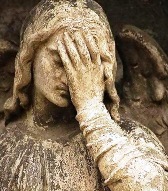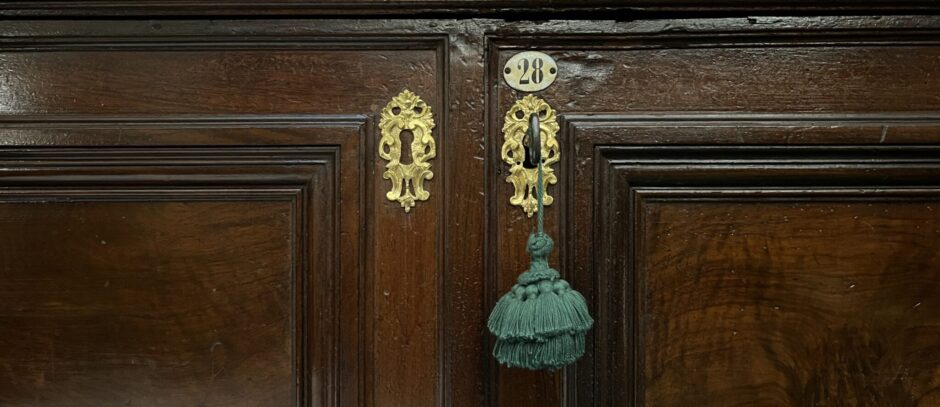First, pray for Thom Peters’ continued recovery.
 The well-known canonist, Thom Peter’s father, has a great post at his place, In The Light Of The Law. My emphases and comments.
The well-known canonist, Thom Peter’s father, has a great post at his place, In The Light Of The Law. My emphases and comments.
About ‘women’s ordination’, what if Gabriel appeared and said…
Except to offer a quick prayer for the ladies who apparently like playing church the way my daughters liked to play house (you know, it looks sort of real, and participants take it very seriously, but, c’mon, it’s still pretend), my main reaction to the most recent “ordination” of a woman was to yawn. I see no point in trying to explain why, say, these women should take canon law seriously, or what the effects of excommunication really are (or are not, for that matter), for they’ve already declared such concerns irrelevant. Fine.
I pause, though, to comment for observers of such antics that, every time these women boast that they have priestly orders by dint of the orders first ‘conferred’ on a woman by a renegade (male) bishop, they miss a crucial point of John Paul II’s ap. lit. Ordinatio sacerdotalis (1994),the document precluding, forever, the possibility of female priests.
The central assertion in Ordinatio is not, repeat not, sacramental (about the nature of orders) nor even ontological (about the nature of women). It’s ecclesiological (about the nature of the Church). Grasp that, and one has the essence of the thing.
No one disputes that the bishop who first simulated conferral of orders on a woman could himself confer orders, and no one (who’s actually read it) claims that Ordinatio formally addresses the capacity of women to receive orders.
Rather, Ordinatio asserts something about the Church, namely, that “the Church has no authority whatsoever to confer priestly ordination on women”. Ordinatio is not about orders, nor even about women, it’s about the Church and about what Jesus authorized his Church to do, or not do, with priestly orders in regard to women. Mind, there might well be sacramental and ontological obstacles to female ordination, [There are… but Dr. Peters point is what we are focused on now like lasers. … What was it again?] but all we know for sure from Ordinatio is that there are ecclesiological obstacles to women priests. Permanent, insurmountable obstacles.
Think of it this way: If Gabriel himself appeared in fiery splendor above St. Peter’s Basilica and proclaimed “Just so you know, women are ontologically capable of receiving priestly Orders!”, not one jot [nor one tittle] of Ordinatio would have to be changed, why? because Ordinatio is not about women or orders, it’s about the Church. The pope, shielding his eyes, could say to Gabriel, “I’m confused, does this mean that we can ordain women priests after all?” Gabriel would respond [with a face-palm], “No! for Pete’s sake, because Jesus did not give that authority to his Church! Read Ordinatio, people. It’s correctly stated in there.”
Given, by the way, the ecclesiological import of Ordinatio, it’s not hard to see why those acting in disregard of it are threatened precisely with excommunication, in that….oops, sorry, I’m starting to talk canon law again, and as we’ve already been informed, ‘women priests’ just ignore canon law.
What a sad group of deluded people.
They need prayers.
The ones I get far more angry with are the protestant heretics who spit on one of the most sacred rites and realities the Catholic Church has by allowing those fake ceremonies in their churches. I have written about that HERE without mincing words.

































but Dr. Peters point is what we are focused on now like lasers. … What was it again?
I believe it was “valid laser beam.” Which was established as a good weapon for the Master Chief.
These are NOT to be confused with INvalid laser beams, the nature of which is so destructive that even the Master Chief–yes, the man himself–dares not to touch them for fear of causing universal collapse.
[Okay… for the Master Chief reference…]
I am happy with the celibate priesthood, and don’t want it to change for Roman Catholics, but I have an observation/question.
The Council of Chalcedon speaks of women being ordained to the diaconate in one of its canons.
Canon 15
“A woman shall not receive the laying on of hands as a deaconess under forty years of age, and then only after searching examination. And if, after she has had hands laid on her and has continued for a time to minister, she shall despise the grace of God and give herself in marriage, she shall be anathematized and the man united to her.”
I assume that was when there existed a permanent diaconate alongside the transitional one (like today).
Do people see a problem with a female diaconate (non-transitional)? and if so, why?
@ Theophilus, why bother with the Council of Chalcedon…women deacons are mentioned in the New Testament. That women deacons (or deaconesses) existed in the early Church is not a surprise or matter of debate. The real question is what did this early female diaconate entail; what was its nature? Until we clear up what is meant by female diaconate/female deacons/women deacons/deaconesses, it is impossible to answer your question.
@inexcels, @Fr.,
I saw that. ;^)
Deaconesses helped deliver stuff to the widows to avoid scandal, helped dip the female folks getting naked-baptized, ran the parish guesthouse, ran the parish school (with the canonesses when there were such things), and ran the parish orphanage when there was one. They also supervised the canonesses, when there were canonesses, and they supervised getting the women catechumens out of church at the “Doors!” part.
It’s all good stuff, but it’s not the same stuff the men did. Deacons were responsible for everybody; deaconesses worked as subordinates of deacons, even if they had the usual vast church-lady powers and territories. Deacons ended up being given more liturgical stuff in the parish as time went on; deaconesses only did the woman usher bits.
@ Suburbanbanshee, the old Catholic Encyclopedia gives a rather more complicated description of deaconesses in the early Church. But in any case, that was my main point to Theophilus, that we need to know what is meant by deaconesses before it can be discussed what is thought about them (i.e., should the Church think about bringing them back).
Methinks that these “Womynpriest” groups probably have a terminal case of Toomanychiefsnotenoughindiansitis. I mean, what are their “parishes” made up of? 5 or 6 “clerics” and 2 or 3 disgruntled ex-nuns? Sounds like an Episcopalian church…*ouch*…
Whenever you write about women doing much of anything, you are extremely hostile. What is the proper role for us? [LOL! I think you may have directed that at me, so I respond: “Piffle!”]
Piffle? That’s what women are supposed to do? [Nooooo… you fundamentally misunderstood what I was trying to convey. “Piffle” is not an action. “Piffle” isn’t a verb. “Piffle” means “nonsense, as trivial or senseless talk”.]Look, I don’t care about Catholic ordination. You stated in you post that there were “ontological” reasons for limiting ordination to men. I presume by this you think there are actual deficiencies in women making us inferior to men in this life. Please state those reasons. If men are not ontologically superior to women, it should be obvious from your description. [What is even more obvious is that this entry is about the ecclesiological issue. It is also obviously that you are here only to provoke a fight. Have a beautiful day, ma’am! o{]:¬) ]
vox borealis,
Scripture doesn’t really help. The scripture references were disputed as to if those deaconesses were just the wives of deacons . Even today, the wife of a priest in the greek tradition is called a presbytera or priests wife.
Am I the only one who, looking at that picture of an angel, thinks of the Doctor and a blue police box?
I repeat what I’ve written on past comment threads, but to Theophilus and vox borealis I respond:
“Deaconesses” were not “female deacons” (despite what a few American Orthodox writers have begun to claim in recent years); deaconesses did not even exist in large parts of the early Church (Rome never, ever had deaconesses; and in the whole of the Latin West they first appear, as a kind of aristocratic abbess, towards the close of the Fourth Century); there is, consequently, no need and no point to reviving “deaconesses” today.
Oh, and one more thing, read Martimort on the subject.
William,
Please elaborate a little more. What of the canon i cited? I see the words “deaconesses” and “ordination” in the undivided Church of antiquity. I don’t understand why it matters if they were regional or not common. To me, it matters more whether or not it was valid and licit. This canon does not seem to support what you are saying(and what I have always thought) about them not really being deacons. Is there a translation issue or missing nuance with the canon? I am asking honestly.
My bad, not the word “ordination”…. but rather “deaconess”, “laying on of hands” and “minister”.